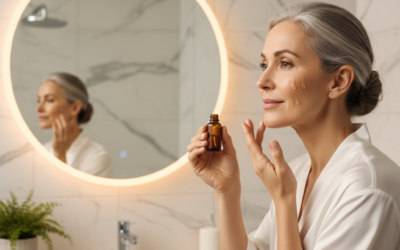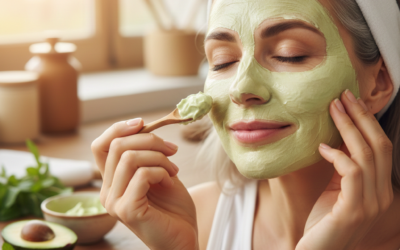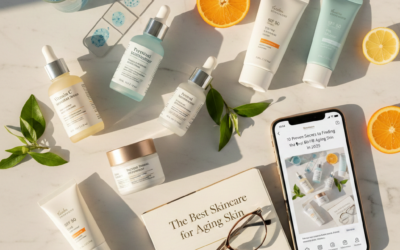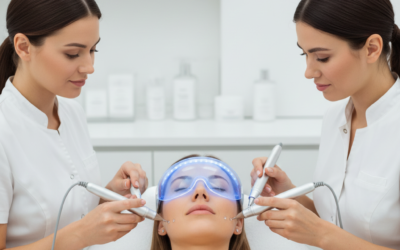How to Fix a Damaged Skin Barrier: The Simple 3-Step ‘Skinimalist’ Routine Dermatologists Recommend.
Table of Contents
Fix a Damaged Skin Barrier: The ‘Skinimalist’ Routine Dermatologists Recommend
You’ve been trying your best—layering serums, exfoliating regularly—but lately, your skin feels tighter, redder, and more sensitive than ever. It’s not your fault; the “more-is-more” trend of complex, multi-step routines likely failed you. You’re experiencing what’s known as a compromised or damaged skin barrier.
The skin barrier, officially called the Stratum Corneum, is your body’s protective outer shield. It’s built like a brick wall: skin cells are the “bricks,” and a mixture of lipids (ceramides, cholesterol, and fatty acids) is the “mortar” holding them together. This essential layer prevents water loss (Transepidermal Water Loss, or TEWL) and blocks environmental irritants, allergens, and bacteria. When that shield breaks down, your skin becomes vulnerable, reactive, and incapable of retaining moisture.
The fix isn’t more products; it’s a radical reduction, a method dermatologists call the Skinimalist Barrier Repair Routine. This approach strips your regimen back to three essential steps, using only clinically proven ingredients to actively rebuild the shield. This guide will show you how to identify a compromised barrier, which aggressive ingredients to stop immediately, and the simple, effective routine to rebuild resilient, glowing skin.
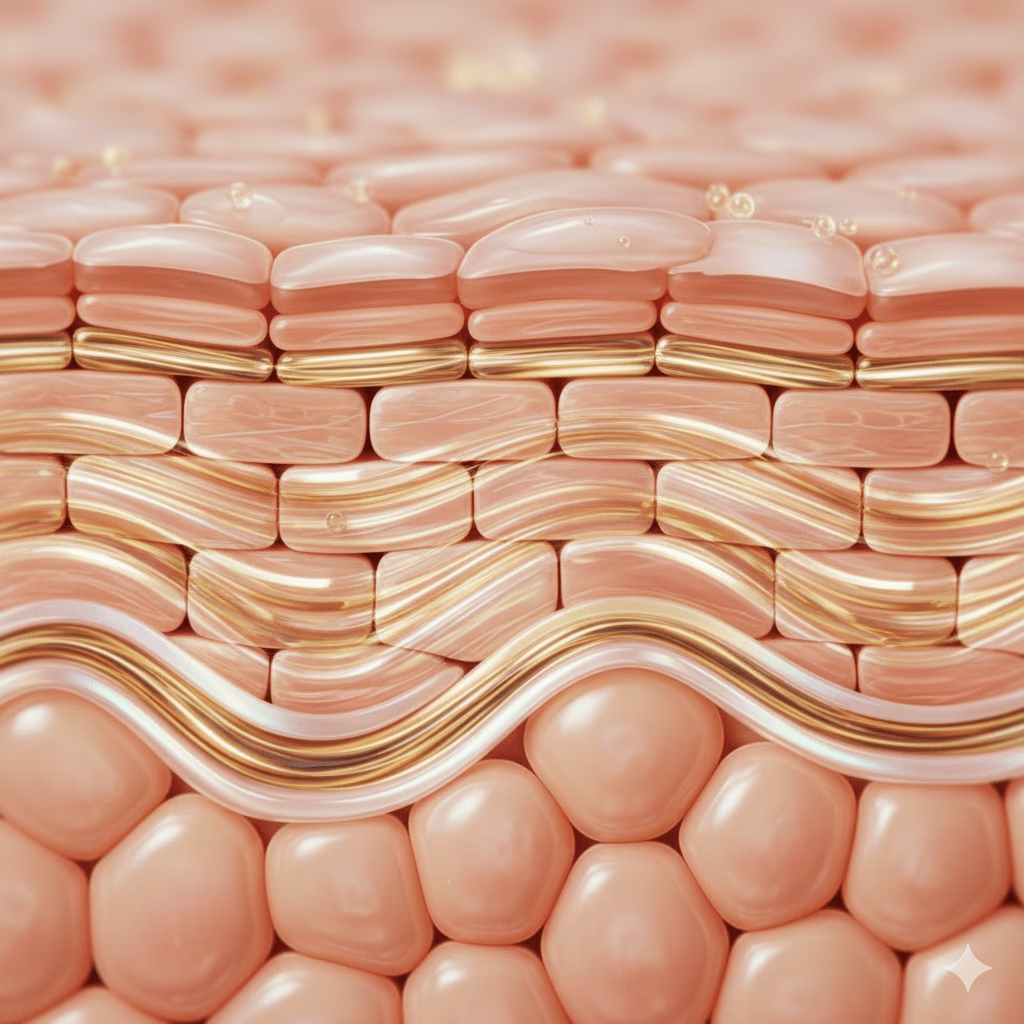
If your skin is red, tight, and sensitive, the “more-is-more” routine broke your protective shield. This guide gives you the dermatologist-backed blueprint to strip back your routine and repair your barrier with three core ingredients: Ceramides, Niacinamide, and Squalane.
Resilient skin starts here.
Is Your Skin Barrier Damaged? The 5 Clear Warning Signs
It’s easy to mistake a compromised barrier for other issues, but the symptoms often appear suddenly, intensely, and simultaneously:
A. Increased Sensitivity
The most telling sign. Products that never bothered you suddenly sting, burn, or itch upon application—even simple moisturizers or mineral sunscreens. This indicates that irritants are penetrating deep into the exposed layers of your skin.
B. Persistent Redness & Inflammation
You may experience facial flushing that lasts longer than normal or general inflammation that won’t go away. This chronic redness is a direct sign that your skin’s built-in anti-inflammatory response is overwhelmed by constant irritation.
C. Unexplained Breakouts
Instead of typical hormonal acne, you get small, rough, patchy bumps, often accompanied by sudden, tiny whiteheads. This is not true acne; it’s a reaction to the damaged barrier’s inability to regulate its microenvironment.
D. Texture Changes
Your skin feels strangely rough, tight, or dull, often accompanied by areas of persistent flakiness or dry patches that don’t respond to hydration. The surface is simply too damaged to reflect light evenly.
E. Transepidermal Water Loss (TEWL)
If your skin feels perpetually “thirsty” and tight, even after applying thick creams, you are experiencing high TEWL. The compromised barrier can no longer hold water in, causing dehydration regardless of your moisturizer.
What Broke Your Barrier? The 3 Biggest Culprits
If you recognize those symptoms, chances are one of these common mistakes led to the breakdown:
A. Over-Exfoliation (Chemical & Physical)
This is the number one culprit. Whether it’s too much Salicylic Acid (BHA), Glycolic Acid (AHA), or physical scrubbing, overuse strips away the lipid layer faster than your skin can replenish it. This aggressive behavior leads to Skincare Burnout, leaving the skin raw and reactive.
B. Over-Using Actives
Attempting to achieve faster results by layering potent ingredients—such as high-concentration Retinol and Vitamin C (especially the highly active, low-pH L-Ascorbic Acid form)—in the same routine, or using them every day, overwhelms the skin’s defense system. High concentrations or frequent usage prevent essential healing time.
C. Environmental Stressors
While skincare choices are usually to blame, the environment can hasten the damage. Exposure to extreme temperatures, low indoor humidity, harsh winds, and excessive sun exposure without proper SPF creates micro-fissures in the protective layer.
The 3-Step Skinimalist Repair Routine
The road to barrier recovery requires patience and discipline, but the reward is resilient, truly healthy skin. For the next four to six weeks, you must commit to this simple, three-step routine—and nothing else.
Step 1: Gentle Cleansing (The Reset)
The immediate goal is to remove impurities without stripping any remaining natural oils. Use a non-foaming, pH-balanced, cream or milk cleanser. Avoid hot water, as it further dries out the skin. During the recovery phase, consider cleansing only once a day (in the evening) and simply rinsing your face with lukewarm water in the morning to minimize trauma.
Step 2: Core Repair Serum/Treatment (The Build)
This is the most critical step, focusing on replacing the barrier’s building blocks. Apply your repair product while your skin is still slightly damp to lock in maximum hydration. You must focus on the power trio of restorative ingredients:
- Ceramides: These are the essential lipid molecules that act as the “mortar” between your skin cells, structurally rebuilding the barrier.
- Niacinamide (2-5%): This form of Vitamin B3 is crucial for calming inflammation, reducing persistent redness, and supporting the skin’s natural production of new ceramides. Stick to low concentrations (2-5%); higher doses can sometimes irritate already sensitive skin.
- Squalane: A highly stable, non-comedogenic oil that mimics your skin’s natural sebum, offering immediate comfort and superior moisture retention without feeling heavy.
Step 3: Protection (The Shield)
The final step is to shield the healing skin from the outside world and prevent any further water loss.
- Morning: Follow your repair serum with a simple, fragrance-free moisturizer and a hydrating SPF 30+. Sun protection is non-negotiable for barrier repair; UV damage actively breaks down the healing process.
- Evening: Use a simple, thick emollient moisturizer. Look for ingredients that act as occlusives—a physical layer that prevents water from evaporating—such as petrolatum, shea butter, or high-molecular-weight hyaluronic acid.
Product Watchlist: Ingredients to STOP and Ingredients to ADD
You must be ruthless about cutting out irritating ingredients for the recovery period.
| Ingredients to STOP (During Repair) | Why? |
|---|---|
| Retinoids (Retinol, Tretinoin, Retinal) | Highly exfoliating; disrupt the cell turnover rate too aggressively. |
| AHA/BHA Acids (Glycolic, Salicylic, Lactic) | Directly strip the lipid layer and drastically increase sensitivity and inflammation. |
| Physical Scrubs | Cause micro-tears and trauma, damaging the protective layer. |
| Strong Fragrance/Essential Oils | Common allergens and irritants that can trigger inflammation in already sensitive skin. |
| Vitamin C (L-Ascorbic Acid) | Its low pH is too acidic for compromised skin, causing significant stinging and inflammation. |
The products you introduce must be purely functional. Look for these building blocks:
| Ingredients to ADD (The Building Blocks) | Function |
|---|---|
| Ceramides | Replaces lost lipids (the mortar) to reinforce the barrier structure. |
| Niacinamide (2-5% concentration) | Reduces redness, minimizes pores, and actively supports ceramide synthesis. |
| Hyaluronic Acid | A powerful humectant that draws water into the skin to address dehydration. |
| Squalane/Oils | Provides an occlusive layer to prevent water loss (TEWL) and soften skin. |
What Comes Next? Reintroducing Actives Safely
Once your skin feels calm, hydrated, and free of the warning signs for at least two weeks (around 4-6 weeks total), you can consider bringing back your favorite actives. Patience is key—introduce only one active ingredient at a time, allowing two weeks to pass before adding a second one.
Reintroducing Vitamin C
Vitamin C Serum is a powerful antioxidant that is essential for neutralizing free radicals, supporting collagen production, and brightening skin tone. While you must pause it during repair due to its acidity, it is excellent for maintenance.
- Start Slowly: Introduce it only in your morning routine, 2-3 times per week.
- Choose a Gentle Form: Consider starting with a gentler derivative like Ascorbyl Glucoside or Magnesium Ascorbyl Phosphate, which are less acidic than L-Ascorbic Acid but still offer great antioxidant benefits.
- Monitor Closely: If you feel any stinging or burning, stop for another week, revert to the repair routine, and try again with a lower concentration.
The Path to Resilient Skin
Remember, barrier repair is a marathon, not a sprint. While you may feel instant comfort from cutting out aggressive ingredients, expect the full cellular recovery process to take a committed four to six weeks. Be patient and consistent—healing is happening at the cellular level, not just on the surface. By embracing this focused skinimalism and prioritizing these core, restorative steps, you’re building a stronger, healthier, and naturally glowing foundation that will eventually be resilient enough to handle your favorite active ingredients again.





